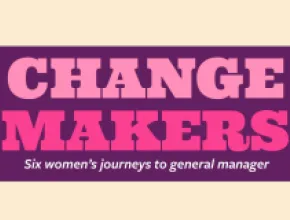The winds of economic unpleasantness whistle through the cracks in the windows with head-spinning alacrity, and by the time Washington figures out the terms of one financial bailout, another industry’s vessel springs a leak. It would seem there are not enough pails to keep pace with the required bailing, and alongside it all, the rest of us try to figure out where we fit into the equation, even as we scratch our heads in wonderment over what that equation actually is.
In the meetings industry, the wind blows strong and from all directions. No strangers to scrutiny of budget performance or accountability, planners now are dealing with the increased strains of a depressed economy and demands of increased returns on what little budget money they are fortunate to have available.
But might there be some leverage available today that didn’t exist before things went south? Could it be possible that, as in the housing market, meeting planners are also enjoying a buyer’s market? The answer is actually yes. But just like in Washington, the trick is in finding the deal that makes the most sense.
Stimulus Borne of Necessity
It comes as no surprise to anyone not hiding in a cave that in the past 12 months economic strains have seeped into the hospitality segment. Inextricably connected as it is to the meetings industry, the time is upon us in which conditions in the hospitality industry as a whole are impacting meetings. The question for 2009 is how exactly this impacts meeting planners, and what does that impact look like in real terms?
First, let’s look at the reality, and what better way to get a bracing slap of it across the cheek than to mine the data. Based on the most recent available figures at the time of this writing, the year-over-year average daily rate (ADR) growth for the U.S. hotel industry has declined, according to figures published by Smith Travel Research, by 0.5 percent. That sort of daily rate decrease—which very likely will decline further—has not been seen since June 2003, when hotels achieved their post 9/11 nadir. And while a negative-point-five decline might seem small as a number, when considered against positive year-over-year numbers of 6 percent and 8 percent, as the industry enjoyed from 2005 to 2007, it is rather abysmal if you happen to run a hotel.
Furthermore, in the convention hotel segment specifically, the numbers tell a grimmer tale. For hotels with a minimum of 300 rooms and meeting facilities of at least 20,000 square feet, the year-to-date (as of October 2008) revenue per available room (RevPAR) has decreased a full percentage point compared with the same time last year. Additionally, the convention segment has shown a decline curve that is lower than the national average in growth rates in both ADR and RevPAR.
While this is not great news for the meetings industry, of course, it is also really bad for everyone, because while convention properties account for just 1.7 percent of U.S. hotels, they also comprise some 12 percent of the overall room supply. It becomes clear, then, that as goes the meetings industry, so goes the hospitality industry.
So what does it all mean for the meeting planner? Although most indicators point to the road getting bumpier before it smooths, for the foreseeable future it appears as though the planner is comfortably in the driver’s seat.
Hotels, meanwhile, are historically reluctant to reduce their room rates—especially as RevPAR and ADR continue to trend downward. Yet they are ever aware on which side of the table they currently sit. Even as they struggle through the economic downturn, they must still attract and retain business. That means great prospects for meeting planners; for the well-prepared planner, the negotiation stage is yielding great returns.
“We know from our research as well as from what we’re hearing that there is in general the resistance to cut rate on the hotel side,” says Duane Vinson, vice president of content management for Smith Travel Research. “What we’re also seeing is that these properties are looking for other ways to draw [the meetings market customer] in. That has manifested in many ways, and I think it differs depending on the situation of a given hotel in a given market. But today some of the additional things hotels would normally charge for they are discounting or giving away.”
Among the list of such items is everything from in-room Internet service to transportation to and from the airport, but the litany of so-called concessions being offered to planners is just the tip of the iceberg. There are far more significant points of leverage available—either implied or overtly advertised—that planners are increasingly using to their advantage.
“I see it happening quite regularly now, says Terri Breining, CMP, CMM, president of San Diego-based meetings management company Concepts Worldwide. “We are seeing more concession and more incentives, specifically for 2009, but not yet quite as much for 2010, because we’re finding that hotels have more on their books for 2010, especially for larger programs. However, for the coming year, we are seeing a great deal of what are being called stimulus options.”
From waiving cancellation fees and reducing attrition fees to providing full-service meetings management, the array of incentives is vast and increasingly multifaceted.
“One of the most interesting things we’ve seen,” Breining says, “is that in lieu of lowering their rate, hotels are actually offering money back into the rate in the form of money that can be put, for example, toward the cost of a convention center. And in some cases, these stimulus options can be used in any way the planner wants. The hotels are being very flexible in those terms.”
Offers You Can’t Refuse
Not only are hotels being more flexible at the negotiation table, they are also being downright solicitous. From free vacation packages to miles for air travel, hotels both nationally and at the individual property level are offering myriad incentives to planners in exchange for their business. Examples abound, but are typified in programs currently offered by most major chains.
While most programs are customized at the property level to suit the particular needs of its market and city, many concessions offers are begun at the macro level. Starwood’s offer of 100,000 bonus Starwood points plus 3 percent off the master bill was helping lure business to the new Sheraton Phoenix Downtown Hotel in the fourth quarter of 2008. At press time, the offer was slated for a likely extension.
Similarly, Wyndham Hotels and Resorts established company-wide initiatives that are tailored by each property. At the Wyndham Chicago Downtown, groups booked by end of the first quarter of 2009 get one free room per 25 consumed rooms, or one suite per 50 rooms, as well as offers including 5 percent off toward a future event, double Windham event reward points, 10,000 frequent flyer miles and a bevy of such meeting-related spiffs as limo transfers to and from the airport and a hosted reception at the bar.
Dolce Hotels and Resorts is offering a “Rebuild Your Meeting” program that provides planners with full-service consultation for clients.
Offers on a regional and local level are also flourishing, including incentives by Marriott resorts in South Florida that can include as much as $45,000 in savings.
Meeting planners who book at one of Omni’s properties and mention the “10K Flyaway” program are eligible to earn 10,000 miles from Delta, United or American airlines for every 100 room nights—the miles amount is doubled if the group is booked on certain Omni-specified dates. Additionally, the planner’s group will get 5 percent off the master bill. It’s then up to the awarded planner to use the miles as personal incentives or rewards for attendees. The program is, in the words of Omni CMO and Senior Vice President of sales Tom Santora, “Our way to say thank you to our valued customers.”
Indeed, the relationship with the customer is paramount during times like these. Relationships lost during down times may never be recovered, lost forever to the competitor who was willing to go the extra mile. This fact burns bright in the minds of hotel operators, many of whom are only recently recovering from the last great economic struggle.
“It’s an interesting time, to be sure,” says Nancy Norman, president of Boston-based event management company The Norman Group. “I think it’s very much like what happened in our industry in the years following 9/11. Business relationships are at the bottom of all of everyone’s ability to succeed. During the time after September 11th, I was with a conference company booking 250 conferences a year. I had to go to hotels we were planning to book with and say, ‘I need you to work with me because I have no idea who is going to show up.’ All of them agreed to that, and it worked because of my relationships with them and because I was being up front and straightforward about it. It worked for both of us.”
The fine line between the need for hotels to maintain rate and to maintain relationships is, in the minds of many planners, where the magic happens. Understanding the pressure many hotels are under to manage rate integrity, planners are working their deals in the margin.
“When this economic crisis was first beginning, all that I heard was that [hotels] cannot lower rate. So what we’ve been saying is give me more for the rate,” Norman says. “I’ve seen many, many offers from hotels around the country offering everything from free breaks and free lunches to free receptions to make up for the rates. At the same time, it’s not wise for hotels to keep rates up high because it will turn delegates away and will turn companies away from allowing their delegates to go to the event. If you are going to keep rates high, you are going to lose business.”
The Rate Stuff
To the naked eye, the onslaught of incentives and concessions currently hitting meeting planner inboxes might seem like some kind of post-Christmas red-tag sale. But the underlying message is, “Take my lunch breaks, please, but don’t ask me to drop my rate.” And although eventual rate reductions may be a foregone conclusion, the practice represents the Forbidden Zone for most hotel management.
“What’s happening is today’s hotel manager is doing everything he or she can to preserve room rates because that is what drives profits,” says Robert Mandelbaum, director of research and information technology for national research and consulting firm PKF Consulting. “A lot of today’s management contracts are based on room rate penetration. So it’s structured right now for bonuses, etc., based on the real profit generated by room rates. You can sacrifice room nights, but as long as you can hold rates stable or even increase them slightly that money will drop to the bottom line. So managers really try to hold on to room rates.”
The effects of dropping rates are also, according to Mandelbaum, still fresh in the minds of many managers—who were in place during the recent post-9/11 downturn. That economic slide “hit a lot of managers hard,” he says. The rate drops resulting from that period were exceedingly difficult to recover from and hotels are understandably reticent to do down that path again. However, in the estimation of PKF, this downturn will be different.
“Simultaneously with that [downturn],” Mandelbaum says, “was the onset of two wars, we had the SARS scare, which effectively wiped out travel to some parts of the United States, and what many people don’t account for was the explosion of websites like Priceline and Hotwire; these distribution channels that will sell hotel rooms for less. So managers would sign on to lower room rates to compete with these other channels. Today, however, hotels have gotten a handle on this third-party leakage and they are not having to give away inventory.”
But neither are hotel managers numb to reality. Their requirement to wheel and deal is acute, and has grown increasingly so with each volley of bad economic news. Hence, the value-add phenomenon.
“Hotels have turned to this proposition of value,” Mandelbaum says. “They are saying, ‘Let me package my hotel with other attractions in the area, or how about I give you a credit in the restaurant.’ The point is, they are willing to work to secure your business.”
Ultimately, the value is in the eye of the beholder. One planner’s need for complimentary audiovisual for all meeting spaces is another’s free coffee during all breaks. At the Intercontinental San Francisco, where planners are being offered—along with a litany of other attractive incentives—two free gallons of coffee for every one gallon purchased, the morning brew has been an effective stimulus.
“We wanted to make sure we stayed ahead of the game in terms of being competitive, and when we looked closely we found that one of the most expensive things seems to be coffee,” says Gail Gerber, director of sales and marketing for the property. “We are writing contracts with it now and planners are just jumping at the concept.”
But as eye-opening as that concession is, it’s ultimately less about the actual coffee and more about simply being responsive to the needs of meeting planners and their clients.
“If everyone in your city is offering something to attract business, and we’re all essentially on an even playing field,” Gerber says, “the thought process then becomes: How can I differentiate myself? How can I put myself on the forefront and have planners say, ‘Wow, this hotel really understands what is going on and what I need.’ The whole point is to create a win-win. If the client wins a little more in the down economy it is not a bad thing. Every client has a different list of needs. Maybe it’s free coffee or maybe it’s something else. But we just want you to come back again in 2010.”
It Takes Partnership
The laundry list of concessions on offer can be interpreted as olive branches.
In difficult times, nobody wants to feel as if they are slogging along alone in the wilderness. So it happens that planners and suppliers are most successful when working toward common goals. This is different than it was earlier this decade, when planners could take advantage of reduced rates and let the chips fall where they may. In this market, there appears to be greater understanding that all parties involved deserve a fair shake.
“No one wants that rate integrity to be compromised, because that hurts everybody,” says Shelby Greene, CMP, purchasing and key account manager for Concepts Worldwide. “Once rates are compromised, it’s hard to get back to where you need to be, and ultimately the hotel’s overall quality can be at risk. Of course, as a planner I would love to see rates go down, but I also understand that if you can’t do it with your rate, there are some other ways we can go about this. It’s about finding out what the client wants.”
“The same holds true on the planner’s side,” Greene continues. “We all have to be creative with our clients while not compromising what we want to do. We have to be more nimble and more creative with what we are offering across the board.”
Hotels and meeting facilities are in the fortunate position of dealing with a customer who has more than their own self-improvement at heart. Whereas leisure travelers are arming themselves with tips culled from how-to travel websites and ready to talk hotels as far down as they will possibly go, planners negotiate with the long term in mind.
“One thing that meeting planners really have to be careful about,” says Loretta Lowe, CMP, a San Francisco-based independant meeting planner, “is not to so significantly reduce the hotel’s profits that you compromise service. I've seen planners wheel and deal food and beverage prices so low that when it came time for their event, the hotel had no recourse but to cut portion sizes and reduce the number of staff. The hotels are not nonprofit organizations and they do need to make a profit to survive.”
It’s easy to be pessimistic when facing down what could potentially be a major economic crisis. But many planners, like Norman, also see opportunity. Partnerships are a part of that chance.
“The good thing that can and should happen through all of this is that we all have to think of more innovative ways to do things,” she says. “We need to rethink it and strategize better. This will cause us to be more creative together with suppliers to make this work. Because if there aren’t mutual benefits, it can’t work. Through all of this—bad times and good, really—you should be building up your relationships.”






